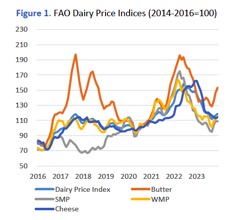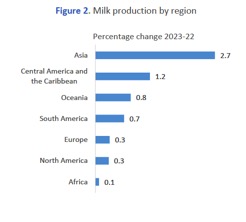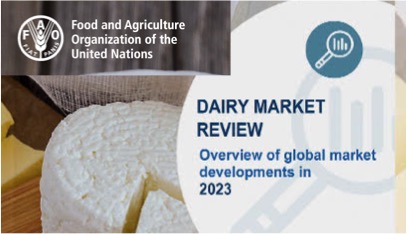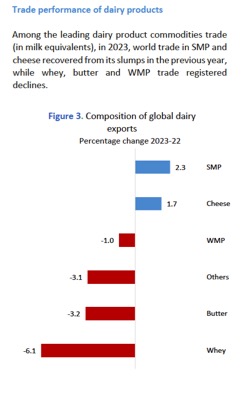International Dairy Prices
In 2023, the FAO Dairy Price Index averaged 123.7, down 17.3% from 2022. Weakness persisted from January to September due to reduced imports by major buyers like China for whole milk powder (WMP) amid high stocks and weakened demand from the HRI sector post-COVID. Increased milk production in China and weakened consumer demand in East Asia and the Middle East further dampened imports. European Union’s higher milk deliveries and reduced market activities in Western Europe also pressured prices. However, since October, prices have risen due to tight export availabilities, seasonal milk supply declines, and weather challenges in Oceania. Currency movements and increased demand from Asia contributed to this trend. FAO indices for skim milk powder (SMP), butter, WMP, and cheese declined, with butter remaining the priciest at an average of $5,100 per tonne, followed by cheese, WMP, and SMP at $4,486, $3,327, and $2,693 per tonne, respectively.

Global Milk Production
In 2023, global milk production rose by 1.5% to 965.7 million tonnes, driven mainly by growth in Asia, accounting for 46% of global output. India and China led the expansion, while other countries like Pakistan and Turkey also saw notable increases. However, Japan and South Korea reported declines. In Europe, production increased marginally, with rises in Russia and the EU but declines in Ukraine. South America, Central America, and the Caribbean saw slight increases, particularly in Brazil and Mexico. North America experienced a modest rise, mainly in the US and Canada. Oceania’s production recovered, with increases in New Zealand and Australia. In Africa, production remained stable, with gains in some countries like Tanzania and Kenya, but declines in others like Egypt and Ethiopia due to various factors including weather and economic challenges.





























